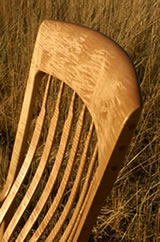 |
||||
 |
 |
 |
 |
 |
Rocking Chairs |
|
"So much furniture today
is so awfully cold. It's
meaningless really. I feel
strongly that one of the
most important things
about a piece of furniture,
is the soul the woodworker
invested in it." |
Building the Rocking ChairSelecting the WoodThe first thing I do when setting out to make a chair is to decide which species of wood intrigues me and would be interesting to work with. I visit the local hardwood supplier and spend hours sorting through piles of lumber until I find the particular pieces that have the look and flow that will compliment the energy and physical form of the chair. The perfect lumber isn’t necessarily the lumber I want. I look for wood with a personality and often find it in the scrap pile because of abnormalities in the grain or color. For example, a dark section of grain in a piece may be rejected by a production shop but it’s the perfect piece for me to use to highlight a chair’s unique shape and contour. Mapping it OutOnce I’ve brought the wood home and laid it out in the shop, I let it acclimate while I study the color and grain to visualize each individual piece and how it will flow together on the finished chair. As I begin to mill the wood, I adapt the original plan based on how the wood is developing as I progress. The First Cut (the part where you get to use the power tools)I gradually rough shape the individual chair components preparing to assemble. Funny enough this is when my wife says I do more setup than woodworking. It can take me half an hour to set up for a five second cut.At this point the chairs current physical form dictates the size In order to create a flexible yet strong back support I saw solid wood into thin strips and then reassemble them by layering glue and strips in a cold bend form and clamping it overnight, creating my own hand laminated back slats. The same process is followed for the rockers. Finding BalanceAfter assembly of the major pieces of the chair I fit the headrest and drill holes for the back slats. In order to allow the flexible back support to move with the individual sitting in the chair, the holes in the seat and headrest are drilled at two different angles. This unique design is what makes my chair I add thin strips of wood to the front or back of the rockers in order to get the chair to sit in a naturally comfortable position by itself with balance and symmetry. So, when you sit in the chair it doesn’t lean to far back, feeling off balance, or too far forward preventing you from relaxing. Blocks to CurvesAt this point it is possible to see the rough shape of the rocking chair. However, to develop it from square blocks of wood to the graceful flowing curves that invite you to be seated I use simple hand tools such as the traditional gutter adz, travisher, and compass hollowing plane. This process is Sand, Sand, Sand Each entire chair is sanded eight different times with various grits of sandpaper up to 1000 grit or until the raw wood is polished enough that it looks and feels as though a fine finish has already been applied. This can take as long as 40 hours per chair. Defining MomentApplying the finish is the big moment. It is when the chair comes to life an the flowing grain is revealed. You never really know how the particulars of a piece of wood are going to react I always make sure that I have ample time after applying the first coat, so that I can simply sit and look at the chair. It is infinitely rewarding. I use the same method and recipe that Sam Maloof developed and used for over 20 years. One coat of finish per day for 8 days. One coat of poly/oil for 4 days. Then one coat of oil/wax per day for the last 4 days. Each is hand rubbed until the rag is warm to the touch, as I move around the chair. Only after the finish has been applied and the chair has become more than just a functional piece of furniture do I feel a true appreciation for my art form. |
208.850.8625 - 850 W Rush Rd - Eagle, ID 83616
Copyright © 2008 Eagle Woodwright Co. All Rights Reserved.
Home | Reché Rocker | The Woodwright | Gallery | Ordering
